Государство и право. Юридические науки. Рубрика в журнале - Journal of Digital Technologies and Law
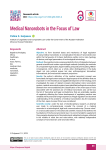
Medical Nanorobots in the Focus of Law
Статья научная
Objective: to form doctrinal bases and mechanics of legal regulation of using medical nanorobots; to conceptualize the idea of nanorobotics law within the frameworks of its basic definitions, safety norms, risks, typology of devices, and legal parameters of technological terminology. Methods: the cognition tools are represented in the form of integration between general scientific and modern special legal methods (including the methods of comparative legal studies, legal modeling and juridical forecasting, NBICS-convergence), which, taken as a whole, allow distinguishing in the study object not only juridical proper, but also anthropological, biomedical, informational, and mechanistic research projections. Results: the author’s definition of the medical nanorobot concept was formulated; the legal content and quasi-legal aspects of the definition that are important for the theoretical and applied development of terminology were investigated; the signs of related concepts (biomedical robot, nanorobotic system, medical nanorobotic system) were identified and logical connections between them were established; the classification of the main types of risks associated with the practical use of medical nanorobots was carried out; the list of theoretical and legal contradictions that are potentially capable of negatively affecting the future development of regulatory practice was revealed; the Russian and foreign experience of legal regulation and doctrinal understanding of the problems of medical nanorobotics (by the examples of the USA, Japan, Europe, China) was considered. Scientific novelty: under the lack of interdisciplinary research, an attempt was made to comprehensively consider the concept of a medical nanorobot in a technological, legal and communicative way (“human robot” on a nanoscale) based on the advanced scientific research that defines the foundations of the future nanorobotic law. It is recommended to supplement the synergetic development of biomedical and related technologies, reflected in the models of robot law and robot ethics, with relatively independent concepts of nanorobot law and nanorobot ethics. Practical significance: based on the analysis of the legal regulation system in force in Russia and abroad, mechanisms for improving domestic legislation were identified, including taking into account the achievements of juridical crowdsourcing. Within the framework of socio-humanitarian issues, a contribution to the development of legal, sociological, and psychological science is formed. A scientific and methodological basis was prepared for further legal research and law-making activities in the field of medical nanorobotics.
Бесплатно
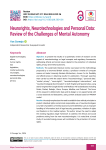
Neurorights, Neurotechnologies and Personal Data: Review of the Challenges of Mental Autonomy
Статья обзорная
Objective: to present the results of a systematic review of research on the impact of neurotechnology on legal concepts and regulatory frameworks, addressing ethical and social issues related to the protection of individual rights, privacy and mental autonomy. Methods: The systematic literature review was based on the methodology proposed by a renowned British scholar, a professor emerita of computer science at Keele University Barbara Kitchenham, chosen for its flexibility and effectiveness in obtaining results for publication. Thorough searches were carried out with the search terms “neurotechnology”, “personal data”, “mental privacy”, “neuro-rights”, “neurotechnological interventions”, and “neurotechnological discrimination” on both English and Spanish sites, using search engines like Google Scholar and Redib as well as databases including Scielo, Dialnet, Redalyc, Lilacs, Scopus, Medline, and Pubmed. The focus of this research is bibliometric data and its design is non-experimental with a cross-sectional and descriptive, using content analysis based on PRISMA model. Results: the study emphasizes the need to establish clear ethical principles to protect individual rights and promote responsible use of neurotechnologies; a number of problems of mental autonomy were identified, such as improper handling of information, lack of legal security guarantees, violation of rights and freedoms in the medical sphere. The author shows the need to adapt the existing regulatory legal framework to address the ethical and social problems arising from the new neurotechnologies. It is noted that a broad study of neurotechnology issues will contribute to the protection of human rights. Scientific novelty: an expanded understanding of the five neurorights within the Universal Declaration of Human Rights is proposed; neurorights are viewed as a new category of rights aimed at protecting mental integrity against the misuse of neurotechnologies. The author justifies the adoption of such technocratic principles as personal identity, free will, mental privacy, equal access and protection against bias. Practical significance: the obtained results are relevant for understanding modern legal concepts related to neurorights and for adapting the existing normative legal acts to solve ethical and social problems arising from the emergence of new technologies, protection of human neurorights and liability for their violation. The study of these issues is key for provision of further responsible development and use of neurotechnologies.
Бесплатно
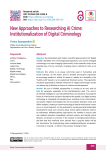
New Approaches to Researching AI Crime: Institutionalization of Digital Criminology
Статья научная
Objective: the article deals with modern scientific approaches to the “digital society”, identifies new criminological perspectives, such as that of digital criminology in an ever-changing hybrid world, in the scientific study of the potential use of AI by criminals, including what is referred to here as AI crime. Methods: this article is an essay commonly used in humanities and social sciences, as the author aims to present provocative arguments to encourage readers to rethink AI issues in relation to criminality in the “hybrid world” based on a non-systematic literature review. The arguments should be supported by relevant references to “digital criminology” and its non-binary way of thinking in favour of a techno-social approach. Results: the era of divided perspectives is coming to an end, and it’s time for synergies, especially at the interdisciplinary level. The «mirror of artificial intelligence» can help identify flaws and solutions, ensuring the future of AI and human society is decided by the people. In a digital society, technology is integrated into people’s lives, including crime, victimization, and justice. Digital technologies blur the boundaries between online and offline realities, creating a human-technological hybrid world where crimes occur in virtual networks. AI has potential for social good and Sustainable Development Goals, but concerns about human rights violations need to be addressed. Multidisciplinary approaches are needed to ensure safe use, address education inequalities, enhance justice, and identify online behavior as deviant or criminal. In the context of emerging technoethics, the idea that this unofficial norm, derived from a popular belief, will be the ‘touchstone’ for characterising online mediated behaviour as deviant/crimninal, is missing - or rather in the process of being formed. Scientific novelty: the author aims to provide some insightful thoughts on formulating the right questions and interesting reflections from a technoethical perspective on the phenomenon of the use of information and communication technologies for criminal purposes under the catalytic influence of AI, recognising the social challenges arising from technological disruption (e.g. prediction and prevention through the transformation of policing, increased surveillance and criminal justice practises) in “digital society”. Practical significance: some of the initial ideas of this theoretical material can be used in the elaboration of proposals for amendements and additions to the current crime legislation, as well as in pedagogical activity, especially in the implementation of educational courses or modules on crime in the context of the digital transformation of society.
Бесплатно
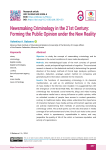
Newsmaking Criminology in the 21st Century: Forming the Public Opinion under the New Reality
Статья научная
Objective: to study the concept of newsmaking criminology and its relevance in the current conditions of mass media development. Methods: the methodological basis of the work consists of general scientific, social, and special-legal methods of cognition. The conducted research is based on the dialectical method (in determining the general direction of the study), methods of formal logic (analysis, synthesis, induction, deduction, analogy), system method (in comparing and generalizing the information collected for the research). Results: the functions of newsmaking criminology in its classical manifestation, as well as its additional functions in the study of mass media in the Internet, were revealed. It is suggested that with the emergence of the World Wide Web, the relevance of newsmaking criminology has increased: social networks, blogs and video hosting as alternative media have a strong influence on public opinion, while an unlimited number of people have access to content generation, contrary to traditional media. Many states understand the importance of interaction between mass media and law enforcement agencies and are actively implementing their methods of promoting newsmaking criminology online. This article points out the risks that arise in media coverage of law enforcement and crime. One of such risks is the cancel culture, which is spontaneous, unpredictable in nature, and may jeopardize the quality of life of the victim or business reputation and activity of organizations. Scientific novelty: the functions performed by newsmaking criminology in the study of traditional and alternative media were identified. So far, such doctrine has not been sufficiently researched taking into account modern forms of mass communication. Examples of interaction between law enforcement agencies of different states and the media were analyzed. Practical significance: the study contributes to understanding the correlation between criminological phenomena and modern media platforms. The Internet and social networks provide new channels of information exchange that differ significantly from traditional media such as printed media or television.
Бесплатно
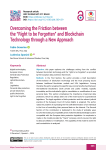
Статья научная
Objective: this paper explores the challenges arising from the conflict between blockchain technology and the “right to be forgotten” as provided by the European data protection framework. Methods: in the First Section, the author provides a brief description of the evolution of blockchain technology and the most pressing issues between traditional blockchain models and UE’s legislations. Among the latter, the author analyzes the specific issue concerning the clash between the traditional blockchains (both private and public models), typically immutable, and the individual’s right to cancellation or modification of own personal data. This section emphasizes the importance of personal data protection, which has always been one of the main tasks for supranational legislators. The legal regulation of data protection and the relevant judicial practice of the European Court of Human Rights is analyzed. The author raises the problem of expressing the free self-determination of an individual in the form of controlling their personal data on the Internet. The Second Section of this contribution is dedicated to the study of probable ways to solve the existing incompatibility and to make the distributed ledger system compatible with the European data protection legislation. An emphasis is made on the model provided by “Traent” company, which ensures the right to data cancellation or modification. The capability of this model to solve the said contradiction is analyzed. Results: the study delves into the peculiar features of the new model to understand how it strategically utilizes the advantages of public and private blockchains guaranteeing not only the validity and authenticity of the chain where the transaction was performed, but, most importantly, the modification and granular cancellation of client’s personal data. This innovative solution offers a potential path forward for navigating the complex intersection of data privacy and blockchain innovation in the European context. Scientific novelty: Traent has implemented a “hybrid” model blockchain that, incorporating both public and private components, to achieve an effective compliance with the European Union regulations, especially those concerning data protection and privacy. Practical significance: the obtained conclusions and proposals can be taken into consideration in improving the compliance of blockchain technologies with the European Union General Data Protection Regulation.
Бесплатно
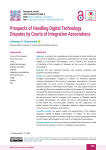
Prospects of Handling Digital Technology Disputes by Courts of Integration Associations
Статья научная
Objective: to analyze the competence and procedure of case handling by the courts of integration associations, allowing them to resolve disputes related to information technologies, and to identify the prospects of handling of this category of disputes by the courts of integration associations. Methods: the main research methods were analysis, synthesis, and problem-theoretical method. Results: the article identified the main features of the “disputes related to digital technologies” category in relation to resolving disputes involving individuals by the courts of integration associations. It reveals opportunities for some courts of integration associations to resolve disputes related to information technologies. The said opportunities are provided by the courts competence, allowing the appeal of individuals, as well as by the dispute resolution procedure involving experts. By analyzing international treaties and practice of courts of integration associations, the author proves that the changes in the category of “disputes related to digital technologies” are related not only to technologies, but also to information and communication systems. By own judgments, the author reveals the content of disputes related to digital technologies in the courts of integration associations. Scientific novelty: the paper reveals the peculiarities of the category “disputes related to digital technologies” in relation to the courts of integration associations and the prospects of resolving disputes related to information technologies by the courts of integration associations. Practical significance: the conclusions provided in the article can be used to improve the practice of courts of integration associations.
Бесплатно
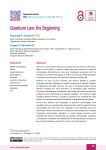
Статья научная
Objective: to formulate the bases for quantum law as the law of the future, based on the study of quantum phenomena and features of quantum technologies determining the risks and challenges associated with the emergence of these technologies, as well as the analysis of legal regulation of quantum technologies in the Russian Federation and abroad. Methods: to carry out this research, the authors applied a complex of general scientific methods of systemic analysis and specific methods of engineering and legal sciences. The use of comparative-legal method allowed revealing the main directions of developing legal regulation of quantum technologies in the Russian and foreign law orders based on the analysis of their international and national regulation. The method of legal modeling allowed forming a concept of quantum law, revealing the main vectors of its development and the complex of its ethical-legal principles. Results: the features and properties of quantum technologies were revealed which can change the development of law with the advent of these technologies; the main risks and challenges were identified which are associated with the development of quantum technologies; the features of quantum technologies regulation in some foreign countries were specified; the trends of developing the quantum technologies regulation in the Russian Federation were identified; the conceptual bases of quantum law were formulated, as well as the vectors of its development. Scientific novelty: for the first time in the legal science, a complex analysis of the current national (both Russian and foreign) regulation of quantum technologies was carried out, based on which an attempt was made to substantiate the need to form quantum law and to outline the main vectors of its development. Practical significance: the research results lay the foundation for forming the concept of quantum law; in this regard, the authors’ conclusions and proposals for improving the current regulation of quantum technologies can be used in law-making and law enforcement in this sphere, and may lay the bases for further research in the sphere of quantum technologies.
Бесплатно
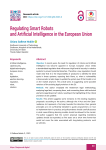
Regulating Smart Robots and Artificial Intelligence in the European Union
Статья научная
Objective: In recent years, the need for regulation of robots and Artificial Intelligence has become apparent in Europe. European Union needs a standardized regulation that will ensure a high level of security in robotics systems to prevent potential breaches. Therefore a new regulation should make clear that it is the responsibility of producers to identify the blind spots in these systems, exposing their flaws, or, when a vulnerability is discovered in a later stage, to update the system even if that model is not on the market anymore. This article aims at suggesting some possible revisions of the existing legal provisions in the EU. Methods: The author employed the Kestemont legal methodology, analyzing legal text, comparing them, and connecting them with technical elements regarding smart robots, resulting in the highlighting of the critical provisions to be updated. Results: This article suggests some revisions to the existing regulatory proposals: according to the author, although the AI Act and the Cyber-resilience Act represent a first step towards this direction, their general principles are not sufficiently detailed to guide programmers on how to implement them in practice, and policymakers should carefully assess in what cases lifelong learning models should be allowed to the market. The author suggests that the current proposal regarding mandatory updates should be expanded, as five years are a short time frame that would not cover the risks associated with long-lasting products, such as vehicles. Scientific novelty: The author has examined the existing regulatory framework regarding AI systems and devices with digital elements, highlighted the risks of the current legal framework, and suggested possible amendments to the existing regulatory proposals. Practical significance: The article can be employed to update the existing proposals for the AI Act and the Cyber-resilience Act.
Бесплатно
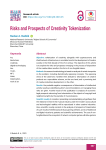
Risks and Prospects of Creativity Tokenization
Статья
Objective: tokenization of creativity, alongside with cryptoeconomy and Web3 network infrastructure, is a notable trend in the development of modern society in the third decade of the 21st century. The objective of this article is to explore the risks and prospects emerging in the process of disposition of the creative labor results in the form of non-fungible tokens. Methods: the research methodology is based on analysis of varied viewpoints on the problem, including diametrically opposing concepts. The opposing views of the observers manifest their attitude to tokenization of creative products as a speculative scheme, on the one hand, and a promising tool of creative industries development, on the other. Results: the probable negative consequences of tokenization of intellectual activity results are identified; author’s recommendations on managing these risks are given. Another result of this publication is analysis of economic-legal prospects stemming from tokenization of the objects of copyright and neighboring rights by the example of musical pieces. Scientific novelty: it consists in presenting and substantiating a hypothesis that the relations formed in the musical industry under the modern sociocultural and technological realities will be reproduced in other creative industries. Also, scientific novelty consists in the analysis of prospects of tokenization of such results of intellectual activity as gaming artifacts, works of traditional and digital visual arts, patents and scientific achievements. The use of non-fungible tokens the ecosystem of network computer games will allow gamers to buy and sell rights to game pieces autonomously from game publishers. Tokenization of industrial property objects and individualization means will ensure protection of intellectual rights of their authors while waiting for the issuance of a state protection document. In the modern society, there will be many of those wishing to become an owner of a token for a scientific work, as the popularity of science and innovations is constantly growing in developed countries. Ownership of a token for a scientific work will be regarded a moral investment, increasing the prestige and status of its owner. Tokens for scientific works have a high potential as a means of measuring value in a post-economic society. Practical significance: it consists in the description of innovative means of using creative products and business models based on tokenization of the results of intellectual activity, ready to be implemented in practice.
Бесплатно

Sovereignty vs. Digital Sovereignty
Статья научная
Objective: the aim of this paper is to analyze the relationship between sovereignty and digital sovereignty in order to determine whether they are linked or autonomous concepts and in which cases and to what extent there is or is not a connection between the two categories. Methods: the methodology is based on the analysis of international, European and national practice and scientific discourse, taking into account sovereignty and digital sovereignty from a threefold perspective: contextual, conceptual and functional. Results: 1) analysis of the correlation between sovereignty and digital sovereignty showed that both are related concepts; 2) important consequences that digital sovereignty has in the case of States and the European Union are defined: a) there is a substantial difference between sovereignty and digital sovereignty because the former is only applied to States, while the latter is also used in reference to the EU; b) digital sovereignty is not necessarily a consequence or an extension of sovereignty; c) while in the case of States, digital sovereignty is justified as a safeguard of traditional sovereignty, in case of European Union its function must necessarily be different, since the European Union lacks sovereignty. Scientific novelty: the analysis of this relationship provides an objective scientific premise for a comprehensive understanding of the idea of digital sovereignty. From the perspective of the context where they operate, as well as their concept and functions, sovereignty and digital sovereignty seem to be autonomous and, in some cases, complementary categories. Practical significance: the dual functionality of digital sovereignty as a concept attached to national sovereignty and as an autonomous concept helps to explain the use of this category in the case of states and in the case of an organization such as the European Union, as well as the differences in its scope and meaning in each scenario.
Бесплатно
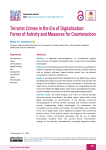
Terrorist crimes in the era of digitalization: forms of activity and measures for counteraction
Статья научная
Objective: to elaborate recommendations on counteraction against terrorist crimes committed in the digital (cyber-) space and/or using digital technologies. Methods: the methodological basis of the research are the universal dialectic method of cognition, the integrity of general and specific scientific methods such as analysis, synthesis, logical method, ascent from the abstract to the specific, induction, deduction, etc. Results: it was determined that the development of the digital (cyber-) space and digital technologies promotes the intensity of terrorism and has led to the change of the mechanism of terrorist crimes commitment. A conclusion was made that, to provide the efficiency of measures for counteracting terrorist crimes committed in the digital (cyber-) space and/or using digital technologies, a distinct strategy is necessary, as well as the appropriate regulatory basis. Scientific novelty: the article analyzes such forms of criminal activities of terrorist groups, committed in the digital (cyber-) space and/or using digital technologies, as dissemination of the ideology of violence and propaganda of terrorist activity, recruiting new members and their training, implementing digital technologies for preparation and immediate terrorist activity, and funding. The advantages were revealed of the use of digital space and/or digital technologies when committing terrorist crimes. In the author’s opinion, the change of the mechanism of terrorist crimes commitment associated with the use of digital technologies should be taken into account during criminalization (change of the intensity of penalization) of publicly dangerous deeds. The important areas of state policy in the sphere of counteraction against these crimes are education and enlightenment activity, training of the personnel of law-enforcement agencies, broadening their authorities to ensure a clear and effective control over digital content. Practical significance: is due to the possibility to use the formulated conclusions and proposals for further scientific elaboration of the state criminal policy in the sphere of counteraction against terrorist crimes committed in the digital (cyber-) space and/or using digita technologies.
Бесплатно
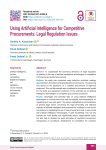
Using Artificial Intelligence for Competitive Procurements: Legal Regulation Issues
Статья научная
Objective: to substantiate the promising directions of legal regulation of relations in the use of artificial intelligence technologies in competitive (commercial and public) procurement. Methods: the study was conducted using induction, synthesis, analogy, decomposition of problems and generalization of conclusions. The reasoning was based on the experience of a complex procurement of high-tech equipment. This real-life example was considered as an experimental model for the study and subsequent prediction of the potential use of artificial intelligence technologies in competitive procurement procedures. Results: advantages and potential risks of using artificial intelligence technologies in procurement work were formulated; recommendations on regulating such use were given. The authors highlighted recommendations of general legal nature concerning the legal personality and delictual capacity of artificial intelligence and proposed the wordings for new norms and options for regulating the use of new procurement tools. It was proved that artificial intelligence technologies, if used thoughtfully, may not only improve the work quality and significantly reduce organizational costs, but also help to develop the basic principles of regulated procurement: transparency of procedures, development of competition for contracts between qualified suppliers, reasonableness of decisions, and economic efficiency of the customer’s expenditures. Scientific novelty: despite a large number of works devoted to both the problems of artificial intelligence in general and its use in procurement in particular, the article considers this topic on the basis of mainly inductive reasoning, built on handling a particular case and experience of complex procurement for knowledge-intensive research, refracted through the prism of essential correlation between the basic concepts of “digitalization”, “automation”, “robotization” and so on. Practical significance: the directions of using artificial intelligence described in this paper can be implemented by corporate and, in the future, by public customers to improve the quality of their procurement. At the same time, the recommendations on the normative regulation of such innovation seem to be in demand both at the legislative and local levels.
Бесплатно
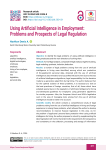
Using Artificial Intelligence in Employment: Problems and Prospects of Legal Regulation
Статья научная
Objective: to identify the legal problems of using artificial intelligence in hiring employees and the main directions of solving them. Methods: formal-legal analysis, comparative-legal analysis, legal forecasting, legal modeling, synthesis, induction, deduction. Results: a number of legal problems arising from the use of artificial intelligence in hiring were identified, among which are: protection of the applicant’s personal data, obtained with the use of artificial intelligence; discrimination and unjustified refusal to hire due to the bias of artificial intelligence algorithms; legal responsibility for the decision made by a generative algorithm during hiring. The author believes that for the optimal solution of these problems, it is necessary to look at the best practices of foreign countries, first of all, those which have adopted special laws on the regulation of artificial intelligence for hiring and developed guidelines for employers using generative algorithms for similar purposes. Also, the European Union’s and USA’s legislative work in the area of managing risks arising from the use of artificial intelligence should be taken into account. Scientific novelty: the article contains a comprehensive study of legal problems arising from the use of artificial intelligence in hiring and foreign experience in solving these problems, which allowed the author to develop recommendations to improve Russian legislation in this area. As for the problem of applicants’ personal data protection when using artificial intelligence for hiring, the author proposes to solve it by supplementing the labor legislation with norms that enshrine the requirements for transparency and consistency in the collection, processing and storage of information when using generative algorithms. The list and scope of personal data allowed for collection should be reflected in a special state standard. The solution to the problem of discrimination due to biased algorithms is seen in the mandatory certification and annual monitoring of artificial intelligence software for hiring, as well as the prohibition of scoring tools for evaluating applicants. The author adheres to the position that artificial intelligence cannot “decide the fate” of a job seeker: the responsibility for the decisions made by the algorithm is solely on the employer, including in cases of involving third parties for the selection of employees. Practical significance: the obtained results can be used to accelerate the development and adoption of legal norms, rules, tools and standards in the field of using artificial intelligence for hiring. The lack of adequate legal regulation in this area creates significant risks both for human rights and for the development of industries that use generative algorithms to hire employees.
Бесплатно
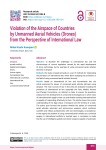
Статья научная
Objective: to illustrate the challenges to international law and the shortcomings of current regulation caused by the rapid development of drone technology, by the example of using unmanned aerial vehicles (drones) in airspace. Methods: the study is based primarily on a set of methods for interpreting the provisions of international law, which allow analyzing the provisions in the field of using unmanned aerial vehicles (drones). Results: based on international air law and humanitarian law, the article examines the issues of unmanned aerial vehicles (drones) using airspace. The main sources of law in this area are analyzed, including the provisions of international air law, especially the Paris, Madrid, Havana and Chicago Conventions. An attempt is made to answer the questions arising from the development of unmanned technologies as to which rules of international law apply to their use and whether existing international law is capable of responding effectively to them. The article shows the current understanding of the legal status of airspace over the territory of a state. The author puts forward the question whether the sphere of unmanned aerial vehicles, automatic and autonomous weapons, which combines scientific and military achievements with new technologies, is exceptional. In this regard, the problem of using unmanned aerial vehicles as a universal weapon in international conflicts is touched upon. A conclusion is made that the use of intelligent, guided and robotic weapons capable of automatic decision-making, such as drones, requires the revision of existing conventions or the establishment of new legal standards for these weapons. It is proposed to consider such drones as military aircraft of a special type. Scientific novelty: international legal responsibility of states for the military use of drones has not received an unambiguous assessment in the doctrine. However, much in this issue depends on the legal interpretation of the most important international legal categories. Further development of this issue is directly related to the issues of international responsibility and the concept of state sovereignty over airspace. Practical significance: the development of unmanned aviation at the present stage demonstrates the imperfection of the existing legal framework, which is designed to regulate these relations. With regard to the study of the global trend in the current international law, the identification of the shortcomings in the provisions of the latter is important primarily for their further modernization, taking into account modern scientific achievements and the development of the concept of a state sovereignty over its airspace.
Бесплатно
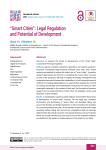
«Умные города»: правовое регулирование и потенциал развития
Статья научная
Цель: исследование тенденций развития концепции «умных городов» и их правового регулирования. Методы: в работе использовались общенаучные (индукция, дедукция) и специальные (системно-структурный, сравнительно-правовой анализ) методы. Кроме того, в исследовании применялись методы обзорного анализа, чтобы изучить статус-кво для «умных городов». До сих пор инновационные исследовательские подходы в рамках рассмотрения концепций «умного города» встречаются редко, как и перспективы, касающиеся целевого управления знаниями и сотрудничества соответствующих заинтересованных сторон. Если говорить о специальных методах исследования цифровых отношений, был использован контент-анализ (метод создания воспроизводимых и обоснованных выводов из текстов (или другого значимого материала) в контексте их использования). Поскольку результаты предыдущих исследований и концепций, касающиеся «умных городов», доступны, также применялся дедуктивный контент-анализ. Результаты: дана характеристика общественных отношений, складывающихся в процессе развития концепции «умных городов». Обозначены ключевые правовые акты, принципы формирования и функционирования «умных городов» с учетом российского и зарубежного опыта. В связи с этим приведены примеры успешных практик из деятельности как российских, так и зарубежных муниципальных образований с учетом проводимых конкурсов, и рейтингов, определяемых центральными структурами. Обобщены популярные направления, широко внедряемые на местном уровне, и выделены возможные проблемы реализации данного проекта в нашем государстве. Научная новизна: в статье осуществлен анализ имеющегося правового регулирования, а также результатов внедрения концепции «умных городов». Определены перспективные технологии и методы, необходимые для достижения целей реализации концепции. Выделены элементы, обеспечивающие устойчивость «умных городов», отвечающих требованиям будущего. Высказана авторская позиция о тесной взаимосвязи данного явления с институтом местного самоуправления в контексте возможного развития последнего с подключением искусственного интеллекта в процесс по принятию управленческих решений. Прежде всего речь идет об использовании потенциала интернета вещей. На практике возникает немалое количество проблем, связанных с реализацией нормативно закрепленных положений, что подразумевает необходимость проведения дальнейших научных исследований в анализируемой сфере. Практическая значимость: обусловлена недостаточной разработанностью данных об особенностях и перспективах внедрения идеи «умных городов». Положения проведенного исследования позволят осуществлять эффективную работу по совершенствованию механизмов правового регулирования рассматриваемой концепции и ее повсеместному распространению.
Бесплатно
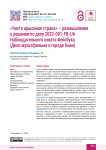
Статья
Цель: в работе представлен анализ решения Наблюдательного совета Фейсбука* по делу 2022-001-FB-UA, известному как «Дело мультфильма о городе Книн». Цель исследования – определение места данного дела в историческом и культурном контексте и выработка критического подхода к проблеме модерирования контента в компании «Фейсбук»*. Методы: основным методом, используемым в работе, является изучение источников. Исследование опирается на сравнительное изучение и анализ кейсов. Использованы положения различных дисциплин, таких как философия права, международное право, право в области средств массовой информации, регулирование деятельности платформ, история. Результаты: в работе представлен контекст дела мультфильма о городе Книн и основные решения Наблюдательного совета Фейсбука* с их обоснованиями. Кроме того, отражена концепция языка ненависти в понимании Наблюдательного совета и сделана попытка показать контекст и описать основные проблемы и возможные решения в области модерирования контента в компании Мета* на примере данного дела. Научная новизна: с момента опубликования решения по делу мультфильма о городе Книн в 2022 г. он не подвергался глубокому историческому и контекстуальному анализу. До настоящего времени вышли лишь несколько работ, анализирующих его с юридической точки зрения. Практическая значимость: полученные результаты важны в трех основных аспектах: (1) они могут быть использованы для дальнейшего критического анализа модерирования контента в компании «Фейсбук»*, (2) они могут служить в качестве рекомендаций в области регулирования деятельности платформ и разработки инструкций и (3) они показывают исключительную актуальность и важность целостного подхода к определению языка ненависти. В рамках последнего аспекта работа доказывает, что историческая, культурная, общественная и символическая интерпретация и понимание проблемы определения языка ненависти является не только практически применимым, но и единственным целесообразным методом для распознавания, определения и вынесения суждения о предполагаемом использовании языка ненависти.
Бесплатно
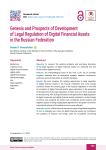
Статья научная
Цель: исследование существующих проблем и перспективных направлений правового регулирования цифровых финансовых активов как относительно нового инструмента современной цифровой экономики. Методы: методологической основой работы выступает совокупность методов научного познания, таких как теоретический анализ, исследование, сопоставление, синтез, а также обобщения научной литературы. Результаты: в работе рассмотрены существующие подходы к правовому регулированию цифровых финансовых активов в Российской Федерации и отдельных зарубежных странах, выявлены существующие пробелы отечественного законодательства в области обращения цифровых финансовых активов, дана оценка перспективам развития правового регулирования указанных инструментов и сформированы предложения по его совершенствованию. Кроме того, в процессе исследования проанализированы подходы к правовому регулированию цифровых валют и цифровых финансовых активов, принятые в ряде иностранных государств, рассмотрены тенденции и отражены положительные и отрицательные моменты использования криптографических алгоритмов для целей экономической и юридической сфер глобальной экономики. Научная новизна: в рамках работы рассмотрены актуальные вопросы законодательного регулирования такого относительно нового явления, как цифровые финансовые активы. Проанализированы позиции отечественных и иностранных ученых-правоведов относительно существующих проблем и рисков, связанных с «токенизацией» и «блокчейнизацией» частного права. Помимо этого, в процессе исследования автор статьи приходит к выводу о существовании значительных пробелов в существующем подходе правового регулирования цифровых финансовых активов, указывает на них и предлагает отдельные механизмы решения данных проблем. Практическая значимость: обусловлена несовершенством существующего законодательства в сфере регулирования отношений, возникающих в процессе использования технологий, базирующихся на базе распределенного реестра, в том числе цифровых финансовых активов. Исследование данных проблем позволяет оценить риски, рассмотреть существующие пути преодоления и разрешения возникающих дискуссионных вопросов. Кроме того, полученные в результате исследования выводы можно использовать для совершенствования отечественного законодательства, а также в учебной литературе, посвященной актуальным вопросам развития цифрового законодательства.
Бесплатно
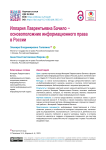
Иллария Лаврентьевна Бачило – основоположник информационного права в России
Статья
Цель: оценка научного вклада Илларии Лаврентьевны Бачило в формирование науки информационного права в России; роли и значения научных трудов И. Л. Бачило для отечественного информационного права. Методы: в статье использовались методы ретроспективного научно-библиографического анализа, анализа и синтеза, сопоставления и взаимопроверки, библиографического изучения документов. Результаты: проведен краткий анализ научной деятельности выдающегося ученого Илларии Лаврентьевны Бачило, описаны наиболее значимые работы, которые, по мнению авторов, явились базовыми в становлении и развитии науки информационного права. Научная новизна: в статье представлены основные этапы и достижения научной жизни И. Л. Бачило, а также отражены персональные оценки и впечатления авторов, сформированные в процессе совместной работы с Илларией Лаврентьевной Бачило. Практическая значимость: информация, представленная в статье, позволит ученым, в особенности молодым специалистам, начинающим исследователям, познакомиться с личностью и деятельностью великого ученого, глубокого и умного человека, память о котором останется навсегда в сердцах сотрудников созданного ею сектора информационного права
Бесплатно
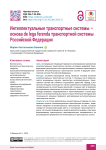
Статья
Цель: исследование тенденций правового регулирования применения интеллектуальных транспортных систем в условиях цифровой трансформации транспортного сектора экономики, а именно нарастающего значения интеллектуальных транспортных систем в будущей транспортной системе Российской Федерации. Методы: системно-структурный метод является основой изучения интеллектуальных транспортных систем. С помощью него представляется возможным изучить архитектуру интеллектуальных транспортных систем как сложного структурного единства. Наряду с указанным методом используются также сравнительно-правовой метод, направленный на иллюстрацию различий и сходных черт в правовом регулировании применения интеллектуальных транспортных систем. Методы правового моделирования и прогнозирования, а также формально-логический метод выступают второстепенными методами для полноценного изучения правового регулирования интеллектуальных транспортных систем. Результаты: в статье представлены концептуальные подходы по определению понятия «интеллектуальные транспортные системы», выделению иерархии интеллектуальных транспортных систем, которым отводится основополагающее место в построении транспортной отрасли. На основе проведенного анализа делаются выводы о векторах формирования транспортного законодательства, направленного на регулирование применения интеллектуальных транспортных систем. Научная новизна: в статье представлен концептуальный подход по формированию правового регулирования интеллектуальных транспортных систем. С этой целью рассмотрен вопрос о сущностном содержании понятия «интеллектуальные транспортные системы» на легальном и научном уровнях, показаны существующие терминологические проблемы для выстраивания правового регулирования. Анализ архитектуры интеллектуальных транспортных систем позволил впервые сформулировать основные подходы к формированию правового регулирования отдельных ее элементов (в том числе высокоавтоматизированных и полностью автоматизированных транспортных средств, «умной» инфраструктуры и т. д.) не обособленно, а как составных частей целого. Практическая значимость: представленный в исследовании материал и сделанные на его основе выводы способствуют развитию правового регулирования транспортной отрасли в условиях цифровой трансформации. В статье делается акцент именно на правовом регулировании интеллектуальных транспортных систем с учетом их технических и технологических особенностей. Именно интеллектуальные транспортные системы являются de lega ferenda транспортной системы, которая предопределяет вектор трансформации транспортного законодательства. В свою очередь разработка правовых основ позволяет расширять географию внедрения технических новелл и делать их применение более масштабным.
Бесплатно
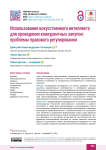
Статья научная
Цель: обоснование перспективных направлений правового регулирования отношений, связанных с использованием технологий искусственного интеллекта в конкурентных (коммерческих и публичных) закупках. Методы: исследование проводилось на основе индукции, синтеза, аналогии, декомпозиции проблематики и обобщения выводов. Рассуждения строились на опыте проведения сложной закупки высокотехнологичного оборудования. Этот реальный пример был рассмотрен в качестве экспериментальной модели для исследования с последующим прогнозированием потенциального использования технологий искусственного интеллекта в конкурентных закупочных процедурах. Результаты: сформулированы преимущества и потенциальные риски использования технологий искусственного интеллекта в закупочной работе, а также даны рекомендации по регулированию такого использования. Выделены рекомендации общеправового характера, касающиеся правосубъектности и деликтоспособности искусственного интеллекта, предложены формулировки новых норм, варианты регулирования использования новых инструментов проведения закупок. Доказано, что технологии искусственного интеллекта при продуманном использовании способны не только повысить качество работы и существенно снизить организационные издержки, но и при этом послужить развитию базовых принципов регулируемых закупок: прозрачности процедур, развития конкуренции за подряд между квалифицированными поставщиками, обоснованности решений, экономической эффективности использования денежных средств заказчика. Научная новизна: несмотря на большое количество работ, посвященных как проблематике искусственного интеллекта в целом, так и его использованию в закупках в частности, данная проблематика рассматривается в статье на основе преимущественно индуктивного рассуждения, строящегося на рассмотрении частного случая и опыте проведения сложной закупки для цели наукоемких исследований, преломляющегося через призму сущностного соотнесения между собой базовых понятий «цифровизация», «автоматизация», «роботизация» и т. п. Практическая значимость: описанные в настоящей работе направления использования искусственного интеллекта могут быть реализованы корпоративными, а в перспективе и государственными заказчиками для повышения качества своих закупок. При этом рекомендации по нормативному регулированию такой инновации представляются востребованными как на законодательном, так и на локальном уровне.
Бесплатно

